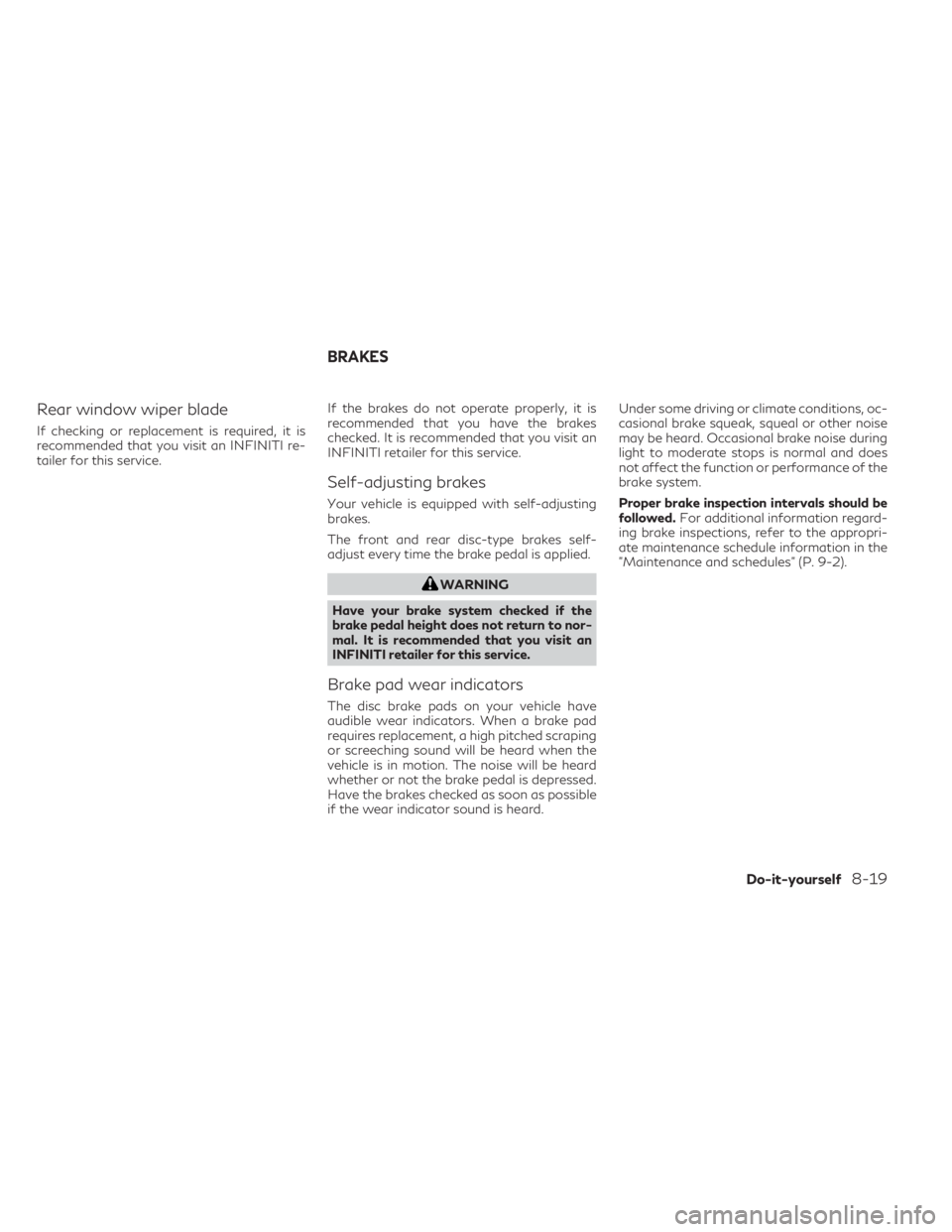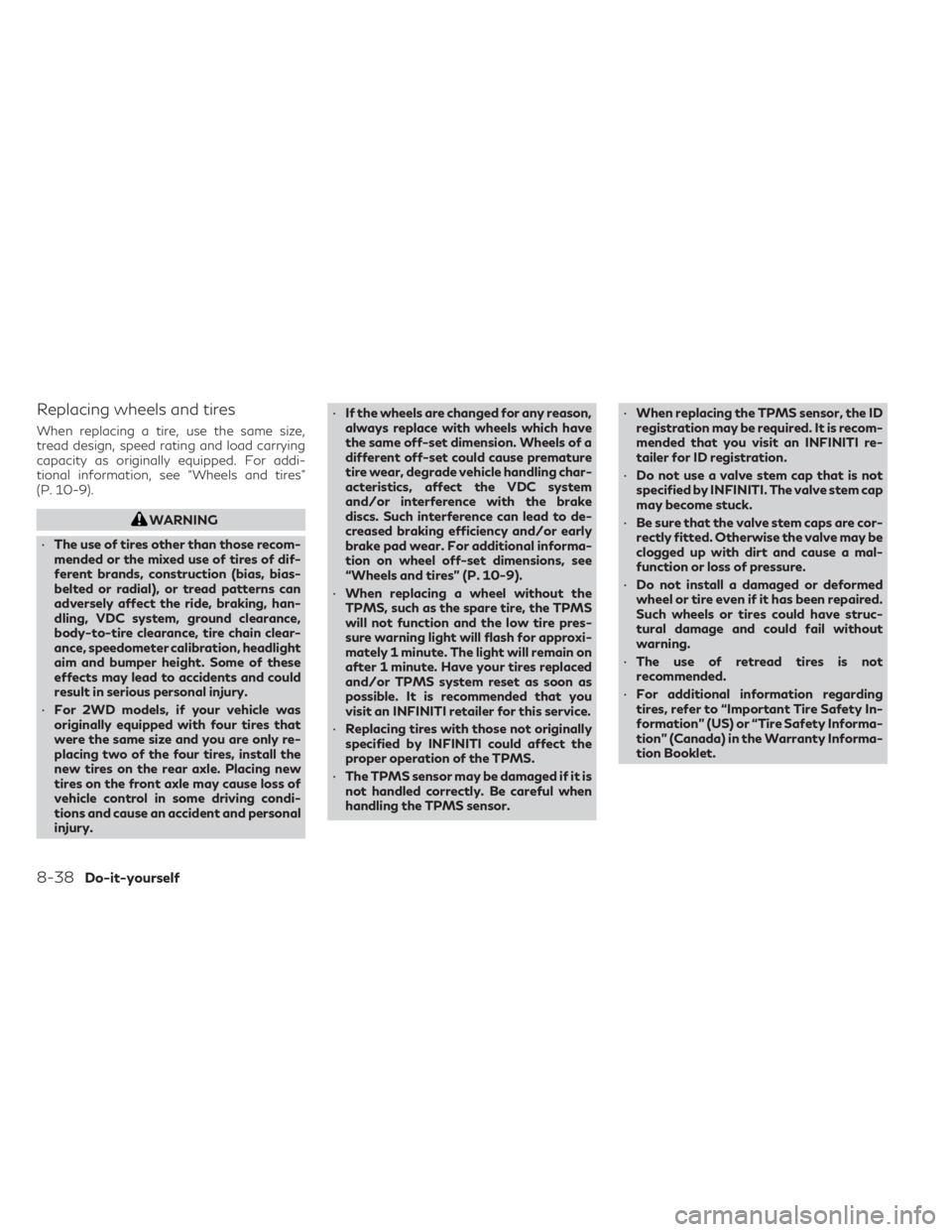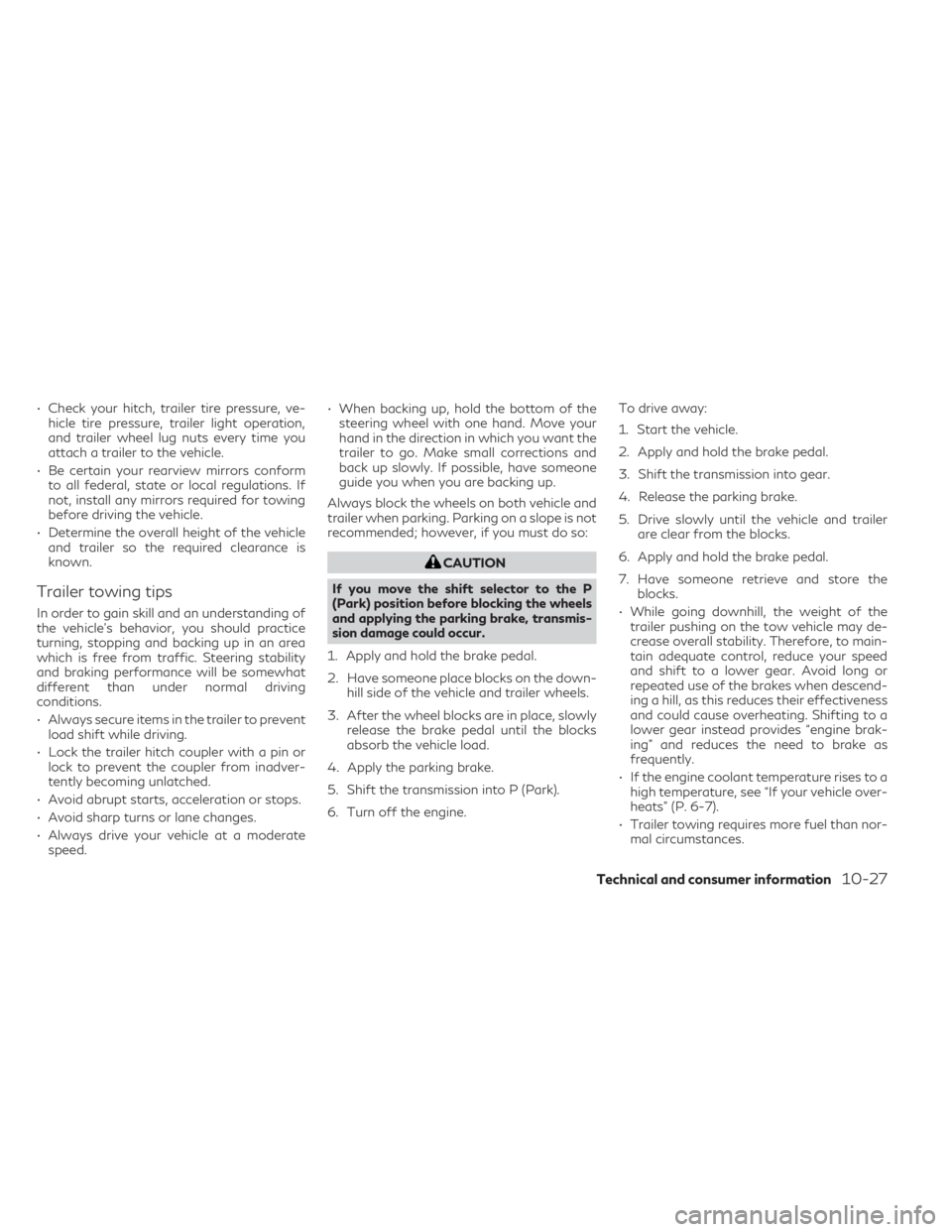height INFINITI QX50 2021 User Guide
[x] Cancel search | Manufacturer: INFINITI, Model Year: 2021, Model line: QX50, Model: INFINITI QX50 2021Pages: 542, PDF Size: 3.51 MB
Page 449 of 542

Rear window wiper blade
If checking or replacement is required, it is
recommended that you visit an INFINITI re-
tailer for this service.If the brakes do not operate properly, it is
recommended that you have the brakes
checked. It is recommended that you visit an
INFINITI retailer for this service.
Self-adjusting brakes
Your vehicle is equipped with self-adjusting
brakes.
The front and rear disc-type brakes self-
adjust every time the brake pedal is applied.
WARNING
Have your brake system checked if the
brake pedal height does not return to nor-
mal. It is recommended that you visit an
INFINITI retailer for this service.
Brake pad wear indicators
The disc brake pads on your vehicle have
audible wear indicators. When a brake pad
requires replacement, a high pitched scraping
or screeching sound will be heard when the
vehicle is in motion. The noise will be heard
whether or not the brake pedal is depressed.
Have the brakes checked as soon as possible
if the wear indicator sound is heard. Under some driving or climate conditions, oc-
casional brake squeak, squeal or other noise
may be heard. Occasional brake noise during
light to moderate stops is normal and does
not affect the function or performance of the
brake system.
Proper brake inspection intervals should be
followed.
For additional information regard-
ing brake inspections, refer to the appropri-
ate maintenance schedule information in the
"Maintenance and schedules" (P. 9-2).
BRAKES
Do-it-yourself8-19
Page 461 of 542

O1Tire size (example: P215/65R15
95H)
1. P: The “P” indicates the tire is de- signed for passenger vehicles (not
all tires have this information).
2. Three-digit number (215): This number gives the width in millime-
ters of the tire from sidewall edge
to sidewall edge. 3. Two-digit number (65): This num-
ber, known as the aspect ratio,
gives the tire's ratio of height to
width.
4. R: The “R” stands for radial.
5. Two-digit number (15): This num- ber is the wheel or rim diameter in
inches. 6. Two- or three-digit number (95):
This number is the tire's load index.
It is a measurement of how much
weight each tire can support. You
may not find this information on all
tires because it is not required by
law.
7. H: Tire speed rating. You should not drive the vehicle faster than the tire
speed rating.
WDI0395
Example
Do-it-yourself8-31
Page 468 of 542

Replacing wheels and tires
When replacing a tire, use the same size,
tread design, speed rating and load carrying
capacity as originally equipped. For addi-
tional information, see “Wheels and tires”
(P. 10-9).
WARNING
• The use of tires other than those recom-
mended or the mixed use of tires of dif-
ferent brands, construction (bias, bias-
belted or radial), or tread patterns can
adversely affect the ride, braking, han-
dling, VDC system, ground clearance,
body-to-tire clearance, tire chain clear-
ance, speedometer calibration, headlight
aim and bumper height. Some of these
effects may lead to accidents and could
result in serious personal injury.
• For 2WD models, if your vehicle was
originally equipped with four tires that
were the same size and you are only re-
placing two of the four tires, install the
new tires on the rear axle. Placing new
tires on the front axle may cause loss of
vehicle control in some driving condi-
tions and cause an accident and personal
injury. •
If the wheels are changed for any reason,
always replace with wheels which have
the same off-set dimension. Wheels of a
different off-set could cause premature
tire wear, degrade vehicle handling char-
acteristics, affect the VDC system
and/or interference with the brake
discs. Such interference can lead to de-
creased braking efficiency and/or early
brake pad wear. For additional informa-
tion on wheel off-set dimensions, see
“Wheels and tires” (P. 10-9).
• When replacing a wheel without the
TPMS, such as the spare tire, the TPMS
will not function and the low tire pres-
sure warning light will flash for approxi-
mately 1 minute. The light will remain on
after 1 minute. Have your tires replaced
and/or TPMS system reset as soon as
possible. It is recommended that you
visit an INFINITI retailer for this service.
• Replacing tires with those not originally
specified by INFINITI could affect the
proper operation of the TPMS.
• The TPMS sensor may be damaged if it is
not handled correctly. Be careful when
handling the TPMS sensor. •
When replacing the TPMS sensor, the ID
registration may be required. It is recom-
mended that you visit an INFINITI re-
tailer for ID registration.
• Do not use a valve stem cap that is not
specified by INFINITI. The valve stem cap
may become stuck.
• Be sure that the valve stem caps are cor-
rectly fitted. Otherwise the valve may be
clogged up with dirt and cause a mal-
function or loss of pressure.
• Do not install a damaged or deformed
wheel or tire even if it has been repaired.
Such wheels or tires could have struc-
tural damage and could fail without
warning.
• The use of retread tires is not
recommended.
• For additional information regarding
tires, refer to “Important Tire Safety In-
formation” (US) or “Tire Safety Informa-
tion” (Canada) in the Warranty Informa-
tion Booklet.
8-38Do-it-yourself
Page 505 of 542

WHEELS AND TIRES
Wheel typeOffset in (mm) Size
Aluminum 1.54 (39)19 x 7.5J
1.73 (44) 20 x 8.5J
Tire size P235/55RF19
P255/45RF20
Spare tire Not equipped
DIMENSIONS AND WEIGHTS
Overall lengthin (mm) 184.8 (4,693)
Overall width in (mm) 74.9 (1,903)
Overall height in (mm) 66.1 (1,679)
Front track 19 inch wheel in (mm) 64.4 (1,635)
20 inch wheel in (mm) 64.0 (1,625)
Rear track 19 inch wheel in (mm) 64.2 (1,630)
20 inch wheel in (mm) 63.8 (1,620)
Wheelbase in (mm) 110.2 (2,800)
Gross vehicle weight rating lbs. (kg) Refer to the “F.M.V.S.S./
C.M.V.S.S. certifica-
tion label” on the
center pillar be-
tween the driver's
side front and rear
doors.
Gross axle weight rating
Front lbs. (kg)
Rear lbs. (kg)
Technical and consumer information10-9
Page 521 of 542

A weight-distributing hitch system (Class IV)
is recommended if you plan to tow trailers
with a maximum weight over 5,000 lbs.
(2,268 kg). Check with the trailer and towing
equipment manufacturers to determine if
they recommend the use of a weight-
distributing hitch system.
NOTE:
A weight-distributing hitch system may af-
fect the operation of trailer surge brakes. If
you are considering use of a weight-
distributing hitch system with a surge
brake-equipped trailer, check with the surge
brake, hitch or trailer manufacturer to de-
termine if and how this can be done.
Follow the instructions provided by the
manufacturer for installing and using the
weight-distributing hitch system.
General set-up instructions are as follows:
1. Park unloaded vehicle on a level surface.With the ignition switch on and the doors
closed, allow the vehicle to stand for sev-
eral minutes so that it can level.
2. Measure the height of a reference point on the front and rear bumpers at the cen-
ter of the vehicle. 3. Attach the trailer to the vehicle and adjust
the hitch equalizers so that the front bum-
per height is within0-.5inches (0 – 13
mm) of the reference height measured in
step 2. The rear bumper should be no
higher than the reference height mea-
sured in step 2.
WARNING
Properly adjust the weight distributing
hitch so the rear of the bumper is no higher
than the measured reference height when
the trailer is attached. If the rear bumper is
higher than the measured reference height
when loaded, the vehicle may handle un-
predictably which could cause a loss of ve-
hicle control and cause serious personal in-
jury or property damage.
Sway control device
Sudden maneuvers, wind gusts, and buffet-
ing caused by other vehicles can affect trailer
handling. Sway control devices may be used
to help control these affects. If you choose to
use one, contact a reputable trailer hitch sup-
plier to make sure the sway control device will
work with the vehicle, hitch, trailer and the
trailer's brake system. Follow the instructions
provided by the manufacturer for installing
and using the sway control device.
Class I hitch
Class I trailer hitch equipment (receiver, ball
mount and hitch ball) can be used to tow
trailers of a maximum weight of 2,000 lbs.
(907 kg).
Class II hitch
Class II trailer hitch equipment (receiver, ball
mount and hitch ball) can be used to tow
trailers of a maximum weight of 3,500 lbs.
(1,587 kg).
Tire pressures
• When towing a trailer, inflate the vehicle tires to the recommended
cold tire pressure indicated on the
Tire and Loading Information label.
• Trailer tire condition, size, load rating and proper inflation pressure should
be in accordance with the trailer and
tire manufacturer's specifications.
Safety chains
Always use suitable safety chains between
your vehicle and the trailer. The safety chains
should be crossed and should be attached to
the hitch, not to the vehicle bumper or axle.
Technical and consumer information10-25
Page 523 of 542

• Check your hitch, trailer tire pressure, ve-hicle tire pressure, trailer light operation,
and trailer wheel lug nuts every time you
attach a trailer to the vehicle.
• Be certain your rearview mirrors conform to all federal, state or local regulations. If
not, install any mirrors required for towing
before driving the vehicle.
• Determine the overall height of the vehicle and trailer so the required clearance is
known.
Trailer towing tips
In order to gain skill and an understanding of
the vehicle's behavior, you should practice
turning, stopping and backing up in an area
which is free from traffic. Steering stability
and braking performance will be somewhat
different than under normal driving
conditions.
• Always secure items in the trailer to preventload shift while driving.
• Lock the trailer hitch coupler with a pin or lock to prevent the coupler from inadver-
tently becoming unlatched.
• Avoid abrupt starts, acceleration or stops.
• Avoid sharp turns or lane changes.
• Always drive your vehicle at a moderate speed. • When backing up, hold the bottom of the
steering wheel with one hand. Move your
hand in the direction in which you want the
trailer to go. Make small corrections and
back up slowly. If possible, have someone
guide you when you are backing up.
Always block the wheels on both vehicle and
trailer when parking. Parking on a slope is not
recommended; however, if you must do so:
CAUTION
If you move the shift selector to the P
(Park) position before blocking the wheels
and applying the parking brake, transmis-
sion damage could occur.
1. Apply and hold the brake pedal.
2. Have someone place blocks on the down- hill side of the vehicle and trailer wheels.
3. After the wheel blocks are in place, slowly release the brake pedal until the blocks
absorb the vehicle load.
4. Apply the parking brake.
5. Shift the transmission into P (Park).
6. Turn off the engine. To drive away:
1. Start the vehicle.
2. Apply and hold the brake pedal.
3. Shift the transmission into gear.
4. Release the parking brake.
5. Drive slowly until the vehicle and trailer
are clear from the blocks.
6. Apply and hold the brake pedal.
7. Have someone retrieve and store the blocks.
• While going downhill, the weight of the trailer pushing on the tow vehicle may de-
crease overall stability. Therefore, to main-
tain adequate control, reduce your speed
and shift to a lower gear. Avoid long or
repeated use of the brakes when descend-
ing a hill, as this reduces their effectiveness
and could cause overheating. Shifting to a
lower gear instead provides “engine brak-
ing” and reduces the need to brake as
frequently.
• If the engine coolant temperature rises to a high temperature, see “If your vehicle over-
heats” (P. 6-7).
• Trailer towing requires more fuel than nor- mal circumstances.
Technical and consumer information10-27